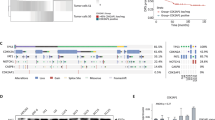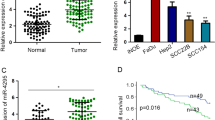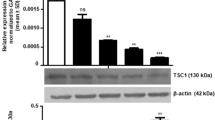Abstract
MicroRNAs (miRNAs) have important roles in the initiation and progression of human cancer, but their role in head and neck cancer development and progression is not well defined. We aimed to determine whether specific miRNAs and their target mRNAs contribute to head and neck cancer pathogenesis and progression. To identify miRNAs associated with head and neck squamous cell carcinomas (HNSCCs), we analyzed HNSCC cell lines, normal head and neck tissues and normal keratinocytes by miRNA profiling; a group of differentially expressed miRNAs was identified, which includes miR-125b. Decreased expression of miR-125b is known to occur in epithelial cancers and many target mRNAs for this miR have been reported. We found decreased expression of miR-125b-1 and hypermethylation of its promoter in HNSCC compared with its non-malignant counterpart. The TACSTD2 (also known as TROP2) gene was identified and validated as a direct target of miR-125b-1. Abnormal expression of TACSTD2 cell-surface glycoprotein has been reported in most epithelial tumors, and the overexpressions of this mRNA and protein product has been considered a useful tumor marker. We report that miR-125b-1 causes mitogen-activated protein kinase pathway dysfunction through regulation of TACSTD2 expression. Thus, loss of miR-125b-1 may have a key role in the pathogenesis and progression of squamous cell carcinomas of head and neck and possibly of other tumors.
This is a preview of subscription content, access via your institution
Access options
Subscribe to this journal
Receive 50 print issues and online access
$259.00 per year
only $5.18 per issue
Buy this article
- Purchase on Springer Link
- Instant access to full article PDF
Prices may be subject to local taxes which are calculated during checkout









Similar content being viewed by others
References
Siegel R, Naishadham D, Jemal A . Cancer statistics, 2012. CA Cancer J Clin 2012; 62: 10–29.
Forastiere A, Koch W, Trotti A, Sidransky D . Head and neck cancer. N Eng J Med 2001; 345: 1890–1900.
Mao L, Hong WK, Papadimitrakopoulou VA . Focus on head and neck cancer. Cancer Cell 2004; 5: 311–316.
Calin GA, Croce CM . MicroRNA signatures in human cancers. Nat Rev Cancer 2006; 6: 857–866.
Croce CM . Causes and consequences of microRNA dysregulation in cancer. Nat Rev Genet 2009; 10: 704–714.
Liu CJ, Tsai MM, Hung PS, Kao SY, Liu TY, Wu KJ et al. miR-31 ablates expression of the HIF regulatory factor FIH to activate the HIF pathway in head and neck carcinoma. Cancer Res 2010; 70: 1635–1644.
Kozaki K, Imoto I, Mogi S, Omura K, Inazawa J . Exploration of tumor-suppressive microRNAs silenced by DNA hypermethylation in oral cancer. Cancer Res 2008; 68: 2094–2105.
Hebert C, Norris K, Scheper MA, Nikitakis N, Sauk JJ . High mobility group A2 is a target for miRNA-98 in head and neck squamous cell carcinoma. Mol Cancer 2007; 6: 5.
Iorio MV, Ferracin M, Liu CG, Veronese A, Spizzo R, Sabbioni S et al. MicroRNA gene expression deregulation in human breast cancer. Cancer Res 2005; 65: 7065–7070.
Henson BJ, Bhattacharjee S, O’Dee DM, Feingold E, Gollin SM . Decreased expression of miR-125b and miR-100 in oral cancer cells contributes to malignancy. Genes Chromosomes Cancer 2009; 48: 569–582.
Ichimi T, Enokida H, Okuno Y, Kunimoto R, Chiyomaru T, Kawamoto K et al. Identification of novel microRNA targets based on microRNA signatures in bladder cancer. Int J Cancer 2009; 125: 345–352.
Visone R, Pallante P, Vecchione A, Cirombella R, Ferracin M, Ferraro A et al. Specific microRNAs are downregulated in human thyroid anaplastic carcinomas. Oncogene 2007; 26: 7590–7595.
Fong D, Moser P, Krammel C, Gostner JM, Margreiter R, Mitterer M et al. High expression of TROP2 correlates with poor prognosis in pancreatic cancer. Br J Cancer 2008; 99: 1290–1295.
Fong D, Spizzo G, Gostner JM, Gastl G, Moser P, Krammel C et al. TROP2: a novel prognostic marker in squamous cell carcinoma of the oral cavity. Mod Pathol 2008; 21: 186–191.
Mühlmann G, Spizzo G, Gostner J, Zitt M, Maier H, Moser P et al. TROP2 expression as prognostic marker for gastric carcinoma. J Clin Pathol 2009; 62: 152–158.
Nakashima K, Shimada H, Ochiai T, Kuboshima M, Kuroiwa N, Okazumi S et al. Serological identification of TROP2 by recombinant cDNA expression cloning using seram of patients with esophageal squamous cell carcinoma. Int J Cancer 2004; 112: 1029–1035.
Ohmachi T, Tanaka F, Mimori K, Inoue H, Yanaga K, Mori M . Clinical significance of TROP2 expression in colorectal cancer. Clin Cancer Res 2006; 12: 3057–3063.
Liu CG, Calin GA, Meloon B, Gamliel N, Sevignani C, Ferracin M et al. An oligonucleotide microchip for genome-wide microRNA profiling in human and mouse tissues. Proc Natl Acad Sci USA 2004; 101: 9740–9744.
Calin GA, Ferracin M, Cimmino A, Di Leva G, Shimizu M, Wojcik SE et al. A MicroRNA signature associated with prognosis and progression in chronic lymphocytic leukemia. N Engl J Med 2005; 353: 1793–1801.
Cubas R, Zhang S, Li M, Chen C, Yao Q . Trop2 expression contributes to tumor pathogenesis by activating the ERK MAPK pathway. Mol Cancer 2010; 9: 253.
Favata MF, Horiuchi KY, Manos EJ, Daulerio AJ, Stradley DA . Identification of a novel inhibitor of mitogen-activated protein kinase kinase. J Biol Chem 1998; 273: 18623–18632.
Kikkawa N, Hanazawa T, Fujimura L, Nohata N, Suzuki H, Chazono H et al. miR-489 is a tumour-suppressive miRNA target PTPN11 in hypopharyngeal squamous cell carcinoma (HSCC). Br J Cancer 2010; 103: 877–884.
Kimura S, Naganuma S, Susuki D, Hirono Y, Yamaguchi A, Fujieda S et al. Expression of microRNAs in squamous cell carcinoma of human head and neck and the esophagus: miR-205 and miR-21 are specific markers for HNSCC and ESCC. Oncol Rep 2010; 6: 1625–1633.
Lee Y, Yang X, Huang Y, Fan H, Zhang Q, Wu Y et al. Network modeling identifies molecular functions targeted by miR-204 to suppress head and neck tumor metastasis. PLoS Comput Biol 2010; 6: e1000730.
Hui AB, Lenarduzzi M, Krushel T, Waldron L, Pintilie M, Shi W et al. Comprehensive MicroRNA profiling for head and neck squamous cell carcinomas. Clin Cancer Res 2010; 16: 1129–1139.
Avissar M, Christensen BC, Kelsey KT, Marsit CJ . MicroRNA expression ratio is predictive of head and neck squamous cell carcinoma. Clin Cancer Res 2009; 15: 2850–2855.
Scott GK, Goga A, Bhaumik D, Berger CE, Sullivan CS, Benz CC . Coordinate suppression of ERBB2 and ERBB3 by enforced expression of micro-RNA miR-125a or miR-125b. J Biol Chem 2007; 282: 1479–1486.
Xia HF, He TZ, Liu CM, Cui Y, Song PP, Jin XH et al. MiR-125b expression affects the proliferation and apoptosis of human glioma cells by targeting Bmf. Cell Physiol Biochem 2009; 23: 347–358.
Liang L, Wong CM, Ying Q, Fan DN, Huang S, Ding J et al. MicroRNA-125b suppressesed human liver cancer cell proliferation and metastasis by directly targeting oncogene LIN28B2. Hepatology 2010; 52: 1731–1740.
Shi XB, Xue L, Yang J, Ma AH, Zhao J, Xu M et al. An androgen-regulated miRNA suppresses Bak1 expression and induces androgen-independent growth of prostate cancer cells. Proc Natl Acad Sci USA 2007; 104: 19983–19988.
Huang L, Luo J, Cai Q, Pan Q, Zeng H, Guo Z et al. MicroRNA-125b suppresses the development of bladder cancer by targeting E2F3. Int J Cancer 2011; 128: 1758–1769.
Yamamoto N, Uzawa K, Miya T, Watanabe T, Yokoe H, Shibahara T et al. Frequent allelic loss/imbalance on the long arm of chromosome 21 in oral cancer: evidence for three discrete tumor suppressor gene loci. Oncol Rep 1999; 6: 1223–1227.
Yamada H, Yanagisawa K, Tokumaru S, Taguchi A, Nimura Y, Osada H et al. Detailed characterization of a homozygously deleted region corresponding to a candidate tumor suppressor locus at 21q11-21 in human lung cancer. Genes Chromosomes Cancer 2008; 47: 810–818.
Negrini M, Rasio D, Hampton GM, Sabbioni S, Rattan S, Carter SL et al. Definition and refinement of chromosome 11 regions of LOH in breast cancer: identification of a new region at 11q23-q24. Cancer Res 1995; 55: 3003–3007.
Rasio D, Negrini M, Manenti G, Dragani T, Croce CM . Loss of heterozygosity at chromosome 11q in lung adenocarcinoma: identification of three independent regions. Cancer Res 1995; 55: 3988–3991.
Zhang Y, Yan LX, Wu QN, Du ZM, Chen J, Liao DZ et al. miR-125b is methylated and functions as a tumor suppressor by regulating the ETS1 proto-oncogene in human invasive breast cancer. Cancer Res 2011; 71: 3552–3562.
Bueno MJ, Pérez de Castro I, Gómez de Cedrón M, Santos J, Calin GA, Cigudosa JC et al. Genetic and epigenetic silencing of microRNA-203 enhances ABL1 and BCR-ABL1 oncogene expression. Cancer Cell 2008; 6: 496–506.
Nakanishi H, Nakamura T, Canaani E, Croce CM . ALL1 fusion proteins induce deregulation of EphA7 and ERK phosphorylation in human acute leukemias. Proc Natl Acad Sci USA 2007; 104: 14442–14447.
Le MT, Teh C, Shyh-Chang N, Xie H, Zhou B, Korzh V et al. MicroRNA-125b is a novel negative regulator of p53. Genes Dev 2009; 23: 862–876.
Gupta S, Davis RJ . MAP kinase binds to the NH2-terminal activation domain of c-Myc. FEBS Lett 1994; 353: 281–285.
Acknowledgements
We thank Dr Kay Huebner (Ohio State University) for careful editing of this manuscript and Sharon Palko (Ohio State University) for administrative support.
Author contributions: HN and CMC designed research; HN, RC, and TK performed research; HN, CT, JP, CFC, SV, and CMC analyzed data; HN and CMC wrote the paper. All authors critically reviewed and edited the paper.
Author information
Authors and Affiliations
Corresponding author
Ethics declarations
Competing interests
The authors declare no conflict of interest.
Additional information
Supplementary Information accompanies the paper on the Oncogene website
Supplementary information
Rights and permissions
About this article
Cite this article
Nakanishi, H., Taccioli, C., Palatini, J. et al. Loss of miR-125b-1 contributes to head and neck cancer development by dysregulating TACSTD2 and MAPK pathway. Oncogene 33, 702–712 (2014). https://doi.org/10.1038/onc.2013.13
Received:
Revised:
Accepted:
Published:
Issue Date:
DOI: https://doi.org/10.1038/onc.2013.13
Keywords
This article is cited by
-
DNA demethylation and tri-methylation of H3K4 at the TACSTD2 promoter are complementary players for TROP2 regulation in colorectal cancer cells
Scientific Reports (2024)
-
Targeting microRNAs as a promising anti-cancer therapeutic strategy against traffic-related air pollution-mediated lung cancer
Cancer and Metastasis Reviews (2023)
-
DNA methylation of tumor associated calcium signal transducer 2 (TACSTD2) loci shows association with clinically aggressive renal cell cancers
BMC Cancer (2021)
-
IKKβ overexpression together with a lack of tumour suppressor genes causes ameloblastic odontomas in mice
International Journal of Oral Science (2020)
-
MiR-4295 facilitates cell proliferation and metastasis in head and neck squamous cell carcinoma by targeting NPTX1
Genes & Immunity (2020)



